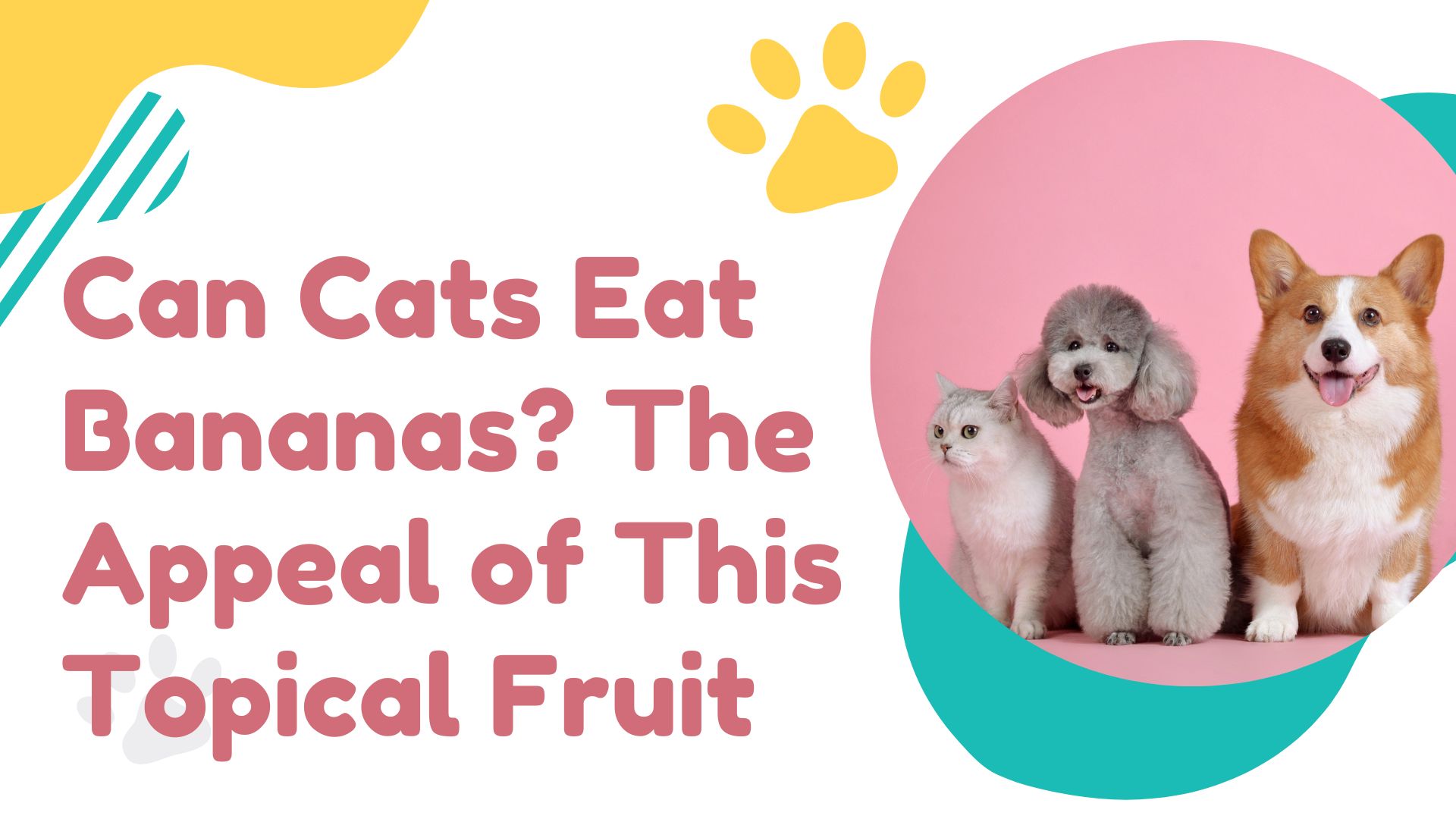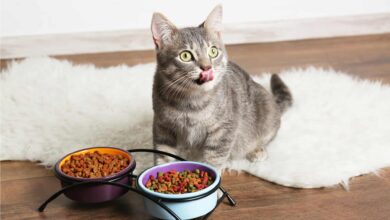
Cats are infamous for being picky eaters, but did you know some kitties go bananas for bananas? Bananas are healthy for humans, but can cats eat bananas too? The answer is yes, but in moderation.
Bananas contain nutrients that are beneficial for cats, but also high amounts of sugar. Let’s explore the pros and cons of feeding bananas to cats and how to do it safely.
Can Cats Eat Bananas? The Short Answer
The short answer is yes, cats can eat small pieces of ripe banana as an occasional treat. Bananas are not toxic or poisonous to felines.

However, they should not make up a significant portion of a cat’s diet due to their high sugar content
Bananas contain vitamin C, vitamin B6, potassium, and prebiotic fiber that can support a cat’s health.
Vitamin C boosts the immune system, B6 helps metabolize food, potassium aids heart function and blood pressure, and prebiotic fiber promotes good digestion.
However, bananas are also high in natural sugars like sucrose, glucose, and fructose. Too much sugar can lead to obesity, diabetes, and digestive upset in cats.
Bananas should be fed in moderation. Check with your vet on safe portion sizes.
Health Benefits of Bananas for Cats
- Potassium – important for heart health and normal blood pressure
- Vitamin C – supports immune system function and antioxidant status
- Vitamin B6 – helps metabolize proteins and carbohydrates
- Prebiotic fiber – promotes growth of healthy gut bacteria and digestion
According to feline nutritionist Dr. Sarah Lane, DVM: “Bananas provide many beneficial nutrients for cats, especially vitamins, minerals, and fiber.
Used as an occasional treat, a few bites of banana can add variety to your cat’s diet without providing excessive calories or sugar.”
Read More: Can Cats Eat Strawberries?
Potential Risks of Feeding Bananas to Cats
- Bananas are high in natural sugars like sucrose, glucose, and fructose – this can lead to weight gain or diabetes if cats consume too much.
- The flesh and strings can pose a choking hazard for cats, especially kittens.
- Some cats may have allergic reactions to proteins in bananas.
- Overripe bananas contain higher sugar content and may cause digestive upset like vomiting or diarrhea.
- Bananas are heavily sprayed with pesticides – traces of these chemicals could potentially make cats sick.
Signs Your Cat Can Eat Bananas
Monitor how your cat reacts to small bites of banana to see if it is a good occasional treat. Bananas are safe for cats that:
- Tolerate small amounts without stomach upset, vomiting, or diarrhea
- Do not have an allergic reaction such as itching, rashes, or facial swelling
- Are adults, not kittens under 12 weeks old (kittens should avoid due to sugar content)
- Maintain a healthy weight and do not become overweight
- Do not have diabetes or tendency towards high blood sugar
- Only receive bananas as an occasional treat, not as a dietary staple
If your cat experiences any negative symptoms or health issues from bananas, discontinue feeding them. The risks outweigh the benefits for cats that have reactions.
Check with your vet before introducing any new foods.
How to Feed Banana to Your Cat
If your cat tolerates bananas well, here are some tips for preparing and serving bananas safely:
- Pick ripe, yellow bananas – avoid unripe green bananas which are harder to digest
- Remove the peel and cut banana into thin slices or small chunks
- Start with just a few tiny pieces and gradually increase to test your cat’s tolerance
- Never give cats the peel or stringy fibers – these are choking hazards!
- For kittens or older cats, mash pieces to make them easier to digest
- Mix a few small mashed pieces into their regular cat food
- Monitor your cat to ensure no digestive upset or allergic reaction
- Do not free-feed bananas – limit portions to 1-2 teaspoons maximum
Check out this quick video tutorial showing how to safely prepare bananas for your cat.
Step-By-Step Recipe – Frozen Banana Cat Treats
Try these healthy homemade frozen treats. Bananas provide vitamins and fiber, Greek yogurt adds probiotics, and peanut butter gives a protein boost.
Ingredients:
- 1 ripe banana, mashed
- 1/4 cup plain Greek yogurt
- 1 teaspoon peanut butter
Directions:
- In a small bowl, mash the banana thoroughly until smooth.
- Mix in Greek yogurt and peanut butter until fully combined.
- Spoon mixture into an ice cube tray.
- Freeze 2-3 hours until firm.
- Pop frozen cubes out and store in an airtight container up to 2 weeks.
- Give your cat 1-2 treats per day. Monitor stool and weight.
How Much Banana Can Cats Eat?
When feeding bananas as a treat, moderation is key. Follow these portion guidelines:
- No more than 1-2 teaspoon sized pieces per day
- Kittens should have even less, starting with just a tiny bite
- Always start with a small amount and watch for reactions
- Do not replace or swap out meals with bananas – just give as occasional snack
- Overfeeding bananas and other fruits can lead to diarrhea or weight gain
Consult your vet on the ideal amount of banana to feed your cat based on age, weight, and health status.
What Type of Banana is Best?
When selecting bananas for your cat, look for:
- Yellow, ripe bananas – avoid underripe green bananas
- Bananas free from brown spots, bruises, or blemishes
- Organic bananas may have fewer pesticide residues
- Baby food bananas are naturally mushy for easy digestion
- Plain bananas – avoid artificial flavors or added sugars
The flesh of ripe, fresh bananas provides the most nutritional benefits and digestibility for cats. Canned or freeze-dried banana treats are another option, but check the ingredient label to ensure no harmful additives
Can Kittens Eat Bananas?
Kittens can eat small tastes of banana, but this sweet fruit should only be an occasional treat, not a dietary staple. Here’s what to know:
- Wait until 12 weeks old to introduce banana to allow digestive system to develop
- Start with just a tiny lick or bite and monitor stool and tummy closely
- Mash or puree banana well to avoid choking hazard
- Pieces should be no larger than 1/4 inch for kittens
- Limit to 1/4-1/2 teaspoon mashed banana 2-3 times weekly at most
- Discontinue if loose stool develops – kittens are prone to diarrhea
Kittens should not consume much banana due to the high natural sugar content. Consult your vet on safe portion sizes.
Can Diabetic Cats Eat Bananas?
Diabetic cats have difficulty regulating blood sugar levels, so fruits high in sugar like bananas are not recommended. Here’s why:
- Bananas have a high glycemic index and carbohydrate content for cats
- This can cause dangerous blood sugar spikes in diabetic felines
- It’s best to avoid bananas entirely and focus diet on high protein, low carb
- If introducing bananas to a diabetic cat, start with a minuscule amount and closely monitor blood glucose
- Discontinue bananas if blood sugar rises significantly
One exception is using a small amount of banana to enhance the flavor of low-carb diabetic cat food, as long as blood glucose is frequently checked.
Overall, bananas and other sugary fruits pose risks for diabetic cats.
Senior cats may have trouble digesting the natural sugars in banana. Risks include:
- Slower GI tract motility means bananas linger longer
- Impaired metabolism of fructose and glucose
- Weight gain is common in older cats – bananas add unnecessary calories
- Dental issues make chewing banana difficult, risking choking
- Kidney disease is more common in seniors – bananas contain potassium that could accumulate
For older cats, try baby food banana or alternatives like pureed pumpkin or unsweetened applesauce instead.
Can Cats Eat Banana Peels, Leaves or Plants?
No – banana peels, leaves, plants, stems, and unripe bananas contain substances toxic to cats:
- Peels: High in tannins and fiber, can cause choking or blockages
- Leaves: Contain anthraquinones that may irritate the gut
- Banana plants/unripe bananas: Contain toxins that could be fatal if eaten
- Other parts of banana plant should be kept away from cats
Only the flesh of ripe, yellow bananas is safe for cats to consume. Never feed peels, leaves, or other banana plant parts.



